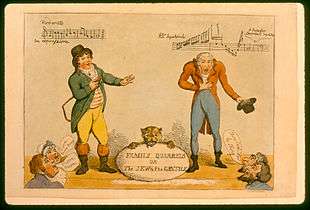Family Quarrels
Family Quarrels is a comic opera in three acts with a libretto by Thomas Dibdin, and music principally by William Reeve. It was premiered in London at Covent Garden Theatre on December 18, 1802.[1] The singers John Braham and Charles Incledon had leading roles in the opera, in which the comedian John Fawcett took the part of the pedlar Proteus.[2]

The opera was evidently also performed in New York in 1806, where the libretto was republished.[3]
Roles
| Role[4] | Voice type | Premiere cast, December 18, 1802 |
|---|---|---|
| Sir Peppercorn Crabstick | ||
| Foxglove | tenor | Charles Incledon |
| Charles Supplejack | tenor | John Braham |
| Proteus, a pedlar | John Fawcett | |
| Argus (valet to Sir Peppercorn) | ||
| Mushroom | ||
| Mrs. Supplejack | ||
| Caroline Crabstick | ||
| Lady Selena Sugarcane | ||
| Betty Lilly, Lady Selena's servant | ||
| Susan (servant to the Crabsticks) | soprano | Nancy Storace |
| Huntsmen, gleaners, anglers | ||
Synopsis
Location: the village where the Supplejack and Crabstick families live.
Foxglove undertakes to reconcile the Supplejack and Crabstick families – Charles Supplejack and Caroline Crabstick wish to marry, but Caroline's parents (who are nouveaux riches) wish her to marry the clothier Mushroom, whilst Mrs. Supplejack's aristocratic pretensions lead her to class Caroline as too lowly. She intends to marry Charles to the widowed Lady Selena. The expected happy ending eventually ensues. The 'Jewish' episode (see below) is not the only 'ethnic' element of the story; at one point the maid Susan disguises herself as a gipsy, whilst Lady Selena's maid – who is sought after by Proteus – is Afro-Caribbean.[5]
Audience reaction
In the course of the action, Proteus disguises himself at one point as ‘Aaron the Jew’, and his song in this character recounts Aaron’s problems in courting Miss Levi, Miss Rachel and Miss Moses: this provoked demonstrations, including cat-calls, from Jews in the audience.[2] Some historians have claimed that Jews in the audience objected to the reference in the song to "three Jewish whores"[6] or even that the performance was " a deliberate attempt [by Dibdin] to please the government...to deflect attention away from the hardship, high taxation and repression...in Britain during the French revolutionary wars". The audience reaction has sometimes been described as a "riot", or more specifically as a "Jewish riot".[7][8]
However the music historian David Conway has noted that there is no evidence for the latter claim, and that the descriptions in the song of Aaron's ladies is perfectly respectable. On referring to the actual music of the song, he attributes the disturbances to the use, in the song's coda, of the melody and rhythm of the synagogue Kaddish prayer. He adds "this musical parody can in fact only have been inserted by Braham himself", as Braham was Jewish and had begun his career as a meshorrer (treble) in the Great Synagogue of London. Conway comments that the use of this sacred melody "may suggest why the Jews in the gallery (who were perhaps more regularly in attendance at synagogue) were more incensed than the gentrified Jews in the boxes, as was reported by the Morning Chronicle",[9] and notes that the song "is the very first presentation I have discovered of genuine Jewish synagogue music in the context of Gentile stage entertainment."[10]
Dibdin's autobiography, in a chapter entitled "And the Twelve Tribes Waxed Wroth", indicates that he included the song exactly in the hope of creating some sensational publicity.[11] By the fourth performance, things had calmed down: Dibdin quotes the newspaper The British Press:
It was reported...that many Jews of the lower class had formed themselves into a regular phalanx, and were to renew their opposition, under the direction of the ass, whose cruel brayings were so successfully exerted the first night. No such occurrence, however, took place...the pedler's [sic] song...was encored amongst the loudest bursts of applause.[12]
Rowlandson's cartoon
Thomas Rowlandson's cartoon "Family Quarrels" depicting Braham and Incledon does not refer explicitly to the disturbances at Covent Garden, but summarizes the rivalry of these two popular favourites, contrasting Braham's floridity (marked "Allegro squeakando") with Incledon's more stolid approach to singing. In the bottom corners are seen the Jewish fans of the former and the gentile fans of the latter.[13]
References
Notes
- Spector 2011, p. 111.
- Conway 2012, p. 85.
- Microform Record, National Library of Australia website, accessed 16 July 2015
- Dibdin 1805, p. ii.
- Dibdin 1805.
- Endelman 1979, p. 217.
- "Theater: England" in Jewish Virtual Library website, accessed 16 July 2015
- Chancellor 2002, p. 20-22.
- Conway 2012, pp. 86–87.
- Conway 2012, p. 88.
- Dibdin 1827, pp. 336–347.
- Dibdin 1827, p. 346.
- Conway 2012, p. 87.
Sources
- Chancellor, Valerie E. (2002). "Anti-Racialism or Censorship? The 1802 Jewish Riots at Covent Garden Opera". Opera Quarterly. 18 (1): 18–25.CS1 maint: ref=harv (link)
- Conway, David (2012). Jewry in Music: Entry to the Profession from the Enlightenment to Richard Wagner. Cambridge: Cambridge University Press. ISBN 9781107015388.CS1 maint: ref=harv (link)
- Dibdin, Thomas (1805). Family Quarrels, A Comic Opera. London: Longman, Hurst, Rees and Orme.CS1 maint: ref=harv (link) Google Books.
- Dibdin, Thomas (1827). The Reminiscences of Thomas Dibdin. London: H. Colburn.CS1 maint: ref=harv (link)
- Endelman, Todd M. (1979). The Jews of Georgian England 1714–1830. Philadelphia: Jewish Publication Society of America.CS1 maint: ref=harv (link)
- Spector, Sheila A., ed. (2011). Romanticism/Judaica: A Convergence of Cultures. Farnham: Ashgate Publishing. ISBN 9780754668800.CS1 maint: ref=harv (link)